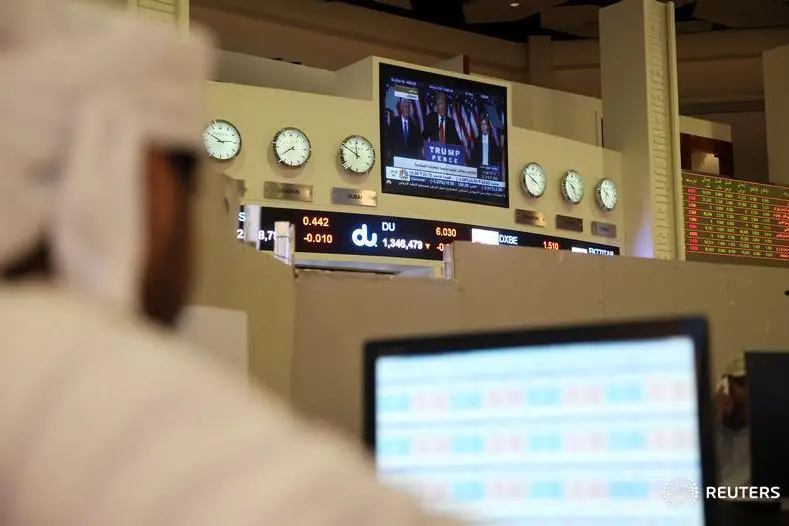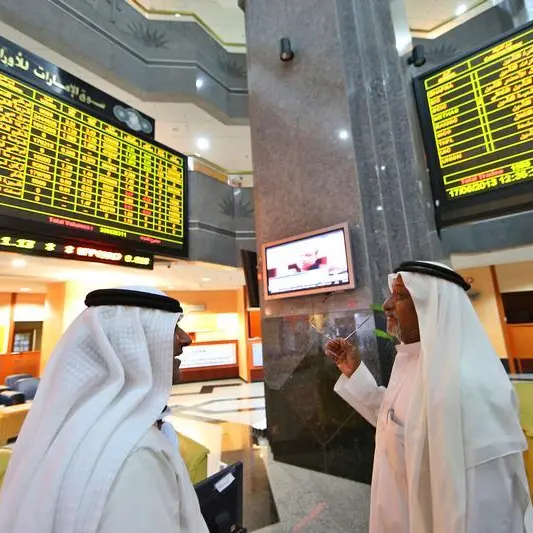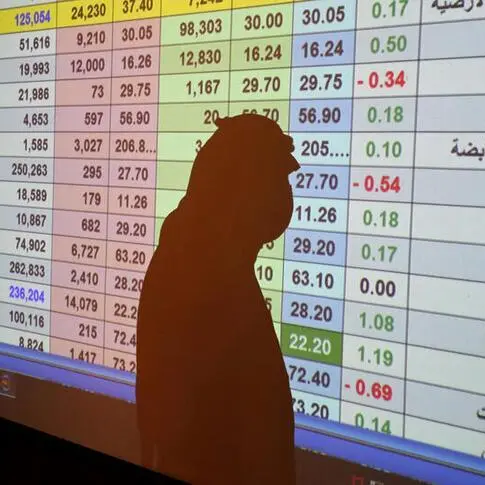PHOTO
The Dubai Financial Market General Index (DFMGI) dropped by 40.76 or 1.18 per cent last week to close at 3,420.17. Most issues were down as there were only seven that advanced against 29 declining. Volume fell to a multi-week low, but that can be attributed to the four-day trading week due to the holiday.
For the past four weeks the DFMGI has been trying to secure a bottom after falling as much as 8.21 per cent from the October peak as of the 3,382.83 low hit two weeks ago. During the recent decline the index retraced approximately 70 per cent of the prior rally that began from the June low. That’s a good amount and therefore it wouldn’t be surprising to see the recent bottom hold and lead to at least a bounce higher.
Further supporting the potential for a rally is the recent price pattern that has formed. It has taken the form of a potential bullish inverse head and shoulders pattern. This is a classic trend reversal pattern that can be used to mark the end of a downtrend and the beginning of an uptrend. Nevertheless, the pattern is not considered valid until there is an upside breakout. Until then the pattern can evolve into a different consolidation pattern and can also just be a rest before the downtrend continues.
A bullish breakout occurs when the index moves above and subsequently closes above the most recent swing high of 3,476.27 on a daily basis. That swing high is also the two-week high.
We can use the size of the pattern to determine a minimum target following a breakout. That calculation produces a potential target of 3,568.7. This is very close to the 61.8 per cent Fibonacci retracement of the most recent downtrend at 3,569.07. Fibonacci analysis is calculating the potential resistance levels for a future rally by using the price distance travelled in the recent downtrend. Given that these two methods, the projection from the head and shoulders pattern and Fibonacci ratio analysis, identify almost same price resistance level, significant resistance can be anticipated around 3,569.
For the past four weeks the DFMGI has been trying to secure a bottom after falling as much as 8.21 per cent from the October peak as of the 3,382.83 low hit two weeks ago. During the recent decline the index retraced approximately 70 per cent of the prior rally that began from the June low. That’s a good amount and therefore it wouldn’t be surprising to see the recent bottom hold and lead to at least a bounce higher.
Further supporting the potential for a rally is the recent price pattern that has formed. It has taken the form of a potential bullish inverse head and shoulders pattern. This is a classic trend reversal pattern that can be used to mark the end of a downtrend and the beginning of an uptrend. Nevertheless, the pattern is not considered valid until there is an upside breakout. Until then the pattern can evolve into a different consolidation pattern and can also just be a rest before the downtrend continues.
A bullish breakout occurs when the index moves above and subsequently closes above the most recent swing high of 3,476.27 on a daily basis. That swing high is also the two-week high.
We can use the size of the pattern to determine a minimum target following a breakout. That calculation produces a potential target of 3,568.7. This is very close to the 61.8 per cent Fibonacci retracement of the most recent downtrend at 3,569.07. Fibonacci analysis is calculating the potential resistance levels for a future rally by using the price distance travelled in the recent downtrend. Given that these two methods, the projection from the head and shoulders pattern and Fibonacci ratio analysis, identify almost same price resistance level, significant resistance can be anticipated around 3,569.
Near-term support is now at last week’s low of 3,406.13, then down to 3,398, followed by the 3,382.83 swing low.
Abu Dhabi
The Abu Dhabi Securities Exchange General Index (ADI) was flat last week, down only 4.00 or 0.09 per cent to end at 4,283.07. There were 11 advancing issues and 20 declining, while volume sank to a multi-week low.
The ADI continued to consolidate in a relatively low volatility range around the lows of the most recent downtrend as it has for the past couple of weeks. Last week’s low is 4,265.69. At that low the index had fallen 5.9 per cent from the swing high of 4,531.65 reached in October.
Although the ADI hasn’t yet rallied off the bottom the chance for such an occurrence is improving. The index has declined for each of the past seven weeks off the October high. This is unusual and the index is statistically unlikely to continue such a trend. In addition, the 14-day Relative Strength Index momentum oscillator (RSI) reached an extreme oversold level two weeks ago and has since turned up. It hasn’t been so oversold since the long-term bottom was hit almost two years ago in January 2016.
Given the above analysis, even if the 4,265.69 support level is breached there may not be enough selling pressure left to push the index much lower. This means that the most likely direction next, is up, even if it only short lived.
A move above last week’s high of 4,318.20 provides the next short-term bullish signal. The ADI then heads up into the bottom of a multi-month consolidation zone, with the first area of resistance likely around 4,355 to 4,396. Downward pressure remains unless the ADI can eventually close above the most recent swing high of 4,531.65.
Stocks to watch
Drake & Scull International was up 9.8 per cent last week to end at 1.91, making it the strongest performer in the Dubai market last week. It’s now looking like the stock is ready to continue its next sustained move which first started off the 1.45 lows in early-October. Following that low Drake & Scull advanced as much as 46.9 per cent in only four week.
Subsequently, the stock went into a five-week retracement that looks to now be coming to an end. That pullback down to a low of 1.64 saw the stock retrace more than two thirds of the prior rally. A decent retracement by any measure.
Last week’s bullish trigger was given on the move above the two-week prior high of 1.86. Strength was confirmed by the weekly close above that resistance zone on Wednesday
Sharp rallies following some period of consolidation as seen in Drake & Scull don’t always occur just once. It is not uncommon to see a second rally or leg up in and uptrend to occur following a period of consolidation and retracement, as we seen in this stock of the past five week.
A simple target can be determined by calculating a measured move, where the second leg up, starting from the low three weeks ago, matches the first rally. If that occurs then Drake & Scull could see an eventual move up to approximately 2.32 at a minimum.
Abu Dhabi
The Abu Dhabi Securities Exchange General Index (ADI) was flat last week, down only 4.00 or 0.09 per cent to end at 4,283.07. There were 11 advancing issues and 20 declining, while volume sank to a multi-week low.
The ADI continued to consolidate in a relatively low volatility range around the lows of the most recent downtrend as it has for the past couple of weeks. Last week’s low is 4,265.69. At that low the index had fallen 5.9 per cent from the swing high of 4,531.65 reached in October.
Although the ADI hasn’t yet rallied off the bottom the chance for such an occurrence is improving. The index has declined for each of the past seven weeks off the October high. This is unusual and the index is statistically unlikely to continue such a trend. In addition, the 14-day Relative Strength Index momentum oscillator (RSI) reached an extreme oversold level two weeks ago and has since turned up. It hasn’t been so oversold since the long-term bottom was hit almost two years ago in January 2016.
Given the above analysis, even if the 4,265.69 support level is breached there may not be enough selling pressure left to push the index much lower. This means that the most likely direction next, is up, even if it only short lived.
A move above last week’s high of 4,318.20 provides the next short-term bullish signal. The ADI then heads up into the bottom of a multi-month consolidation zone, with the first area of resistance likely around 4,355 to 4,396. Downward pressure remains unless the ADI can eventually close above the most recent swing high of 4,531.65.
Stocks to watch
Drake & Scull International was up 9.8 per cent last week to end at 1.91, making it the strongest performer in the Dubai market last week. It’s now looking like the stock is ready to continue its next sustained move which first started off the 1.45 lows in early-October. Following that low Drake & Scull advanced as much as 46.9 per cent in only four week.
Subsequently, the stock went into a five-week retracement that looks to now be coming to an end. That pullback down to a low of 1.64 saw the stock retrace more than two thirds of the prior rally. A decent retracement by any measure.
Last week’s bullish trigger was given on the move above the two-week prior high of 1.86. Strength was confirmed by the weekly close above that resistance zone on Wednesday
Sharp rallies following some period of consolidation as seen in Drake & Scull don’t always occur just once. It is not uncommon to see a second rally or leg up in and uptrend to occur following a period of consolidation and retracement, as we seen in this stock of the past five week.
A simple target can be determined by calculating a measured move, where the second leg up, starting from the low three weeks ago, matches the first rally. If that occurs then Drake & Scull could see an eventual move up to approximately 2.32 at a minimum.
Reporting by Bruce Powers
Bruce Powers, CMT, is a technical analyst and global market strategist.
© Al Nisr Publishing LLC 2017. All rights reserved. Provided by SyndiGate Media Inc. (Syndigate.info).












